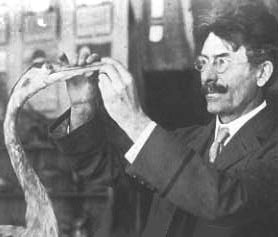Ernest Thompsom Seton
Literary Audubon (1860-1946)
Ernest Thompson Seton is best known for his extraordinary
animal stories, popularized originally in magazines before being reintroduced
in book form as Wild Animals I Have Known (1898). In fact, the fame
of these stories was so widespread they even inspired Rudyard Kipling’s
Jungle
Books (1894-1895). Seton’s particular brand of eccentricity, inner
drive, and self-conviction, however, led him to pursue many other occupations
during his lifetime: naturalist, writer, artist, educator, and explorer.
As well, he was, in 1910, co-founder of the Boy Scouts of America.
Seton was a descendant of the Scottish Setons who
fought for the Stuarts in 1745 and then fled to England under the name
of Thompson. Ernest Thompson Seton (he assumed his family’s historical
identity in his twenties) was born in southern England in August 1860,
the ninth son in a family of ten boys.
When he was six years old, Seton’s family emigrated
to Canada, and for several years they resided on a farm near Lindsay, Ontario,
where Seton began his lifelong study of birds – often catching and dissecting
wildlife to assure that his drawings were realistic.
Falling onto hard times, the family moved to Toronto
in 1870, but Seton found rural sustenance in the wilds of the Don Valley,
the Toronto Marsh, and Queen’s Park, all of which, at that time, teemed
with wildlife. His forays into the wilderness did not, however, interfere
with his studies: his brilliance as a pupil was soon recognized, and he
continued his schooling at Jarvis Street Collegiate. Later, he was apprenticed
to a Toronto portrait artist and then studied at the Ontario College of
Art where he took the Gold Medal in 1879.
For a while he lived with his brother on their farm
in Carberry, Manitoba, and his experience there intensified an interest
in animal life, particularly in coyotes, bears, and wolves.
 |
Although both a naturalist and
writer, Ernest Thompson Seton is best remembered as an illustrator. Upon
graduating from the Ontario College of Art (Gold Medal, 1879), Seton took
up studies in England, France and the United States, winning the Paris
Salon Gold Medal for "The Sleeping Wolf." His most notable book, Wild Animals
I Have Known (1898), profusely illustrated, was immensely popular throughout
the world. [Photo, courtesy National Archives of Canada/PA-164333] |
Through self-discipline and a honing of his artistic
ability, he gained entrance in 1881 to the Royal Academy of Arts in London,
England. Following that experience, he went to New York City and joined
the Art Student League of New York. His painting, “The Sleeping Wolf,”
won first prize at the Paris Salon in 1891. He also finished his illustrated
work, Birds of Manitoba (1891), for Washington’s Smithsonian Institute.
An experience of witnessing the capture of a legendary
old wolf, Lobo, in New Mexico affected Seton for the rest of his life.
Although he continued to dissect animals and to produce books such as Studies
in the Art Anatomy of Animals, he increasingly turned to writing stories
including the four-volume Lives of Game Animals for which he was
awarded the John Burroughs and Elliot Gold Medals.
It is Seton’s books and stories on animals that have
ensured his place in history and, particularly, in the affection of many
North American children. His animal stories are often taken from the animal’s
point of view and invest the animals with such human qualities as curiosity,
desire, and sympathy. Many of these protagonists have become household
names – “Lobo, the King of Currumpaw”; “Raggylug, the Story of a Cottontail
Rabbit”; “Redruff, the Story of the Don Valley Partridge.” In a preface
to his collected works, Seton says:
These stories are true. Although I have left the
line of historical truth in many places, the animals in this book were
all real characters. They lived the lives I have depicted, and showed the
stamp of heroism and personality more strongly by far than it has been
the power of my pen to tell.
The many aspects of life with which Seton was involved
– art, anatomy, wildlife, folklore, exploration, Boy Scouts, Amerindian
history – were pursued with a singular determination that made him stand
apart and win notice, but notice that was not always favourable. In particular,
his custom of investing animal characters with human qualities gained him
the negative and vocal criticism of such influential personalities as Theodore
Roosevelt and John Burroughs.
Because of his keen sense of affinity with the wolf,
especially, Seton began to refer to himself as “Wolf” or “Black Wolf” Seton.
He married twice – in 1896 to Grace Gallatin with
whom he had one daughter (Anya Seton who later wrote historical novels)
– and again in 1935 to Julie Moss Buttree who was 29 years his junior.
In the last few years of his life, he and his second wife established The
Seton Institute of Indian Lore in Cimmaron, New Mexico, which is still
open today as a museum and run successfully by his adopted daughter, Dee.
Patricia Stone
